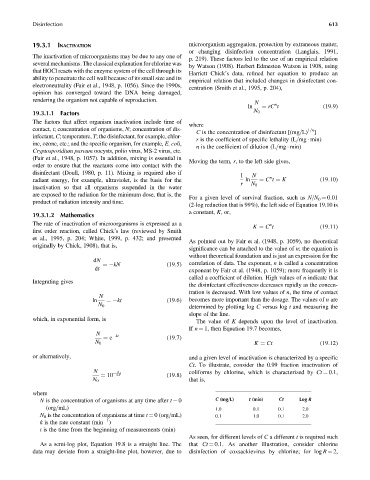Page 658 - Fundamentals of Water Treatment Unit Processes : Physical, Chemical, and Biological
P. 658
Disinfection 613
19.3.1 INACTIVATION microorganism aggregation, protection by extraneous matter,
or changing disinfection concentration (Langlais, 1991,
The inactivation of microorganisms may be due to any one of
p. 219). These factors led to the use of an empirical relation
several mechanisms. The classical explanation for chlorine was
by Watson (1908). Herbert Edmeston Watson in 1908, using
that HOCl reacts with the enzyme system of the cell through its
Harriett Chick’s data, refined her equation to produce an
ability to penetrate the cell wall because of its small size and its
empirical relation that included changes in disinfectant con-
electroneutrality (Fair et al., 1948, p. 1056). Since the 1990s, centration (Smith et al., 1995, p. 204),
opinion has converged toward the DNA being damaged,
rendering the organism not capable of reproduction. N
n
ln ¼ rC t (19:9)
19.3.1.1 Factors N 0
The factors that affect organism inactivation include time of
where
contact, t; concentration of organisms, N; concentration of dis- 1=n
C is the concentration of disinfectant [(mg=L) ]
infectant, C; temperature, T; the disinfectant, for example, chlor-
r is the coefficient of specific lethality (L=mg min)
ine, ozone, etc.; and the specific organism, for example, E. coli,
n is the coefficient of dilution (L=mg min)
Cryptosporidium parvum oocysts, polio virus, MS-2 virus, etc.
(Fair et al., 1948, p. 1057). In addition, mixing is essential in
Moving the term, r, to the left side gives,
order to ensure that the reactants come into contact with the
disinfectant (Doull, 1980, p. 11). Mixing is required also if
1 N n
radiant energy, for example, ultraviolet, is the basis for the ln ¼ C t ¼ K (19:10)
r N 0
inactivation so that all organisms suspended in the water
are exposed to the radiation for the minimum dose, that is, the
For a given level of survival fraction, such as N=N 0 ¼ 0.01
product of radiation intensity and time.
(2-log reduction that is 99%), the left side of Equation 19.10 is
a constant, K, or,
19.3.1.2 Mathematics
The rate of inactivation of microorganisms is expressed as a n
K ¼ C t (19:11)
first order reaction, called Chick’s law (reviewed by Smith
et al., 1995, p. 204; White, 1999, p. 432; and presented
As pointed out by Fair et al. (1948, p. 1059), no theoretical
originally by Chick, 1908), that is,
significance can be attached to the value of n; the equation is
without theoretical foundation and is just an expression for the
dN
¼ kN (19:5) correlation of data. The exponent, n is called a concentration
dt exponent by Fair et al. (1948, p. 1059); more frequently it is
called a coefficient of dilution. High values of n indicate that
Integrating gives
the disinfectant effectiveness decreases rapidly as the concen-
tration is decreased. With low values of n, the time of contact
N
ln ¼ kt (19:6) becomes more important than the dosage. The values of n are
N 0
determined by plotting log C versus log t and measuring the
slope of the line.
which, in exponential form, is
The value of K depends upon the level of inactivation.
If n ¼ 1, then Equation 19.7 becomes,
N kt
¼ e (19:7)
N 0 K ¼ Ct (19:12)
or alternatively, and a given level of inactivation is characterized by a specific
Ct. To illustrate, consider the 0.99 fraction inactivation of
N t coliforms by chlorine, which is characterized by Ct ¼ 0.1,
k
¼ 10 2:3 (19:8)
that is,
N 0
where
N is the concentration of organisms at any time after t 0 C (mg=L) t (min) Ct Log R
(org=mL) 1.0 0.1 0.1 2.0
N 0 is the concentration of organisms at time t ¼ 0 (org=mL) 0.1 1.0 0.1 2.0
1
k is the rate constant (min )
t is the time from the beginning of measurements (min)
As seen, for different levels of C a different t is required such
As a semi-log plot, Equation 19.8 is a straight line. The that Ct ¼ 0.1. As another illustration, consider chlorine
data may deviate from a straight-line plot, however, due to disinfection of coxsackievirus by chlorine; for log R ¼ 2,

